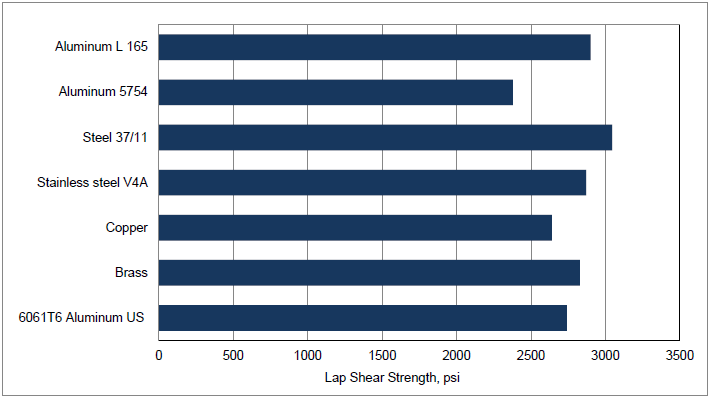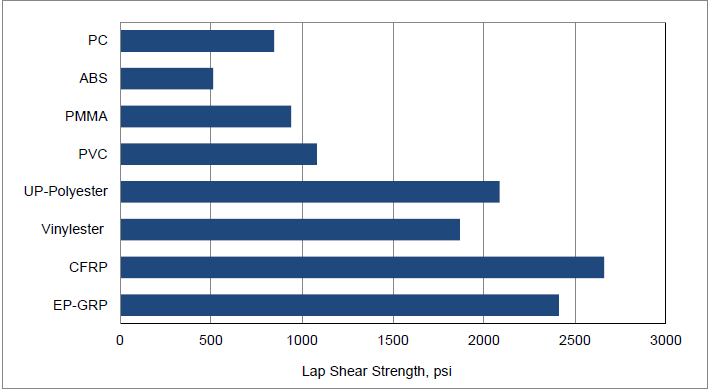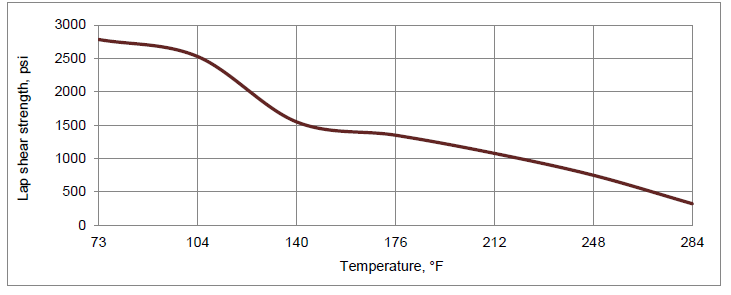Enhanced TDS
Identification & Functionality
- Chemical Family
- RTU Product Type
- Technologies
- Product Families
Features & Benefits
- Ready-to-Use Product Features
- Features and Benefits
- 40-minute open time
- MIN. 30% Elongation at break
- Excellent ageing and weathering resistance
- Resistant to temperatures up to 212°F (100°C)
- Withstands the e-coat post-cure up to 392°F (200°C)
- Minimal substrate pre-treatment needed
- Contains .25 - .3 mm spacer beads
- Product Features
- 40-minute open time
- >30% Elongation at break
- Excellent ageing and weathering resistance
- Resistant to temperatures up to 212°F (100°C)
- Withstands the e-coat post-cure up to 392°F (200°C)
- Minimal substrate pre-treatment needed
- Contains 0.25 - 0.3 mm spacer beads
Applications & Uses
- Compatible Substrates & Surfaces
- Processing Information
Pretreatment
- The strength and durability of a bonded joint are dependent on proper pretreatment of the surfaces to be bonded, however the methacrylate adhesives can be used effectively with little surface preparation.
- Ideally joint surfaces should be cleaned with a good degreasing agent such as acetone, iso-propanol (for plastics) or other proprietary degreasing agents in order to remove all traces of oil, grease and dirt.
- Low grade alcohol, gasoline (petrol) or paint thinners should never be used.
- The strongest and most durable joints are obtained by either mechanically abrading or chemically etching (“pickling”) the degreased surfaces.
Application of adhesive
- This system is available in cartridges incorporating mixers and can be applied as ready to use adhesive with the aid of the tool recommended by Huntsman Advanced Materials.
- The resin/hardener mix may be applied manually or robotically to the pretreated and dry joint surfaces.
- Huntsman's technical support group can assist the user in the selection of a suitable application method as well as suggest a variety of reputable companies that manufacture and service adhesive dispensing equipment.
- A layer of adhesive 0.25 mm thick will normally impart the greatest lap shear strength to the joint.
- The joint components should be assembled and secured in a fixed position as soon as the adhesive has been applied.
Temperature of application: the recommended temperature application range is 50°F to 104°F.
Warning: the cure reaction can generate a high amount of heat, it is not recommended to mix large amounts of material at room temperature.- Application Information
Pretreatment
The strength and durability of a bonded joint are dependent on proper pretreatment of the surfaces be bonded, however the methacrylate adhesives can be used effectively with little surface preparation. Ideally joint surfaces should be cleaned with a good degreasing agent such as acetone, iso-propanol (for plastics) or other proprietary degreasing agents in order to remove all traces of oil, grease and dirt. Low grade alcohol, gasoline (petrol) or paint thinners should never be used. The strongest and most durable joints are obtained by either mechanically abrading or chemically etching (“pickling”) the degreased surfaces.
Application of adhesive
This system is available in cartridges incorporating mixers and can be applied as ready to use adhesive with the aid of the tool recommended by Huntsman Advanced Materials.The resin/hardener mix may be applied manually or robotically to the pretreated and dry joint surfaces. Huntsman's technical support group can assist the user in the selection of a suitable application method as well as suggest a variety of reputable companies that manufacture and service adhesive dispensing equipment. A layer of adhesive 0.25 mm thick will normally impart the greatest lap shear strength to the joint. The joint components should be assembled and secured in a fixed position as soon as the adhesive has been applied. For more detailed explanations regarding surface preparation and pretreatment, adhesive joint design, and the dual cartridge dispensing system.Temperature of application: the recommended temperature application range is 50°F to 104°F.
Warning: the cure reaction can generate a high amount of heat, it is not recommended to mix large amounts of material at room temperature.
Equipment maintenance
All tools should be cleaned with hot water and soap before adhesives residues have had time to cure. The removal of cured residues is a difficult and time-consuming operation. If solvents such as MEK are used for cleaning, operatives should take the appropriate precautions and, in addition, avoid skin and eye contact.
Technical Details & Test Data
- Typical Times to Minimum Shear Strength on Sandblasted Aluminum / Contact Pressure
Temperature 10°C (50°F) 23°C (73°F) 30°C (86°F) 40°C (104°F) Cure time (min) to reach Lap Shear Strength > 145 psi (1MPa) 176 70 25 18 Cure time (min) to reach Lap Shear Strength > 1450 psi (10MPa) 210 75 30 21 - Typical Physical Properties
- Unless otherwise stated, the figures given below were all determined by testing standard specimens made by lap-jointing 114 x 25 x 1.6 mm strips of aluminum alloy.
- The joint area was 12.5 x 25 mm in each case.
- The figures were determined with typical production batches using standard testing methods.
- They are provided solely as technical information and do not constitute a product specification.
Average lap shear strengths of typical metal-to-metal joints (ISO 4587) (typical average values)
- Cured for 24 hours at RT and tested at 73°F. Substrates sandblasted and degreased with acetone.
- They are typical values only, and do not constitute a product specification.
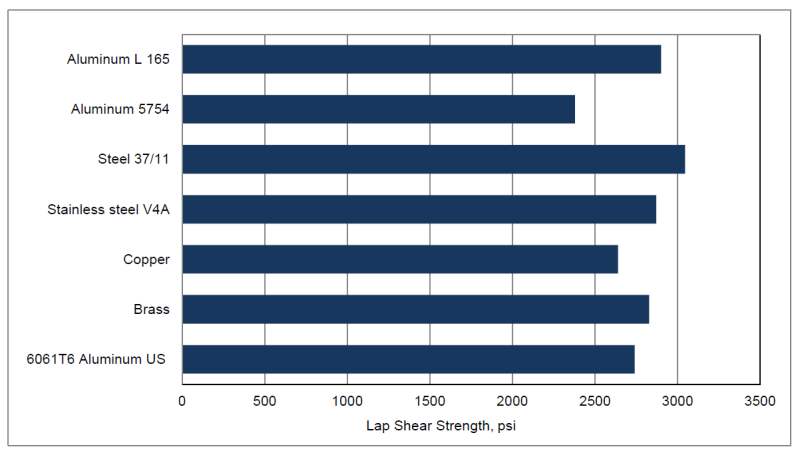
Notes: ARALDITE® 2054-40 is not suitable for galvanized steel - ARALDITE® 2047-1 or ARALDITE® 2051 can be used instead.
Average lap shear strengths of typical plastic-to-plastic joints (ISO 4587) (typical average values).
- Cured for 24 hours at RT and tested at 73°F.
- Substrates abraded and degreased with isopropanol.
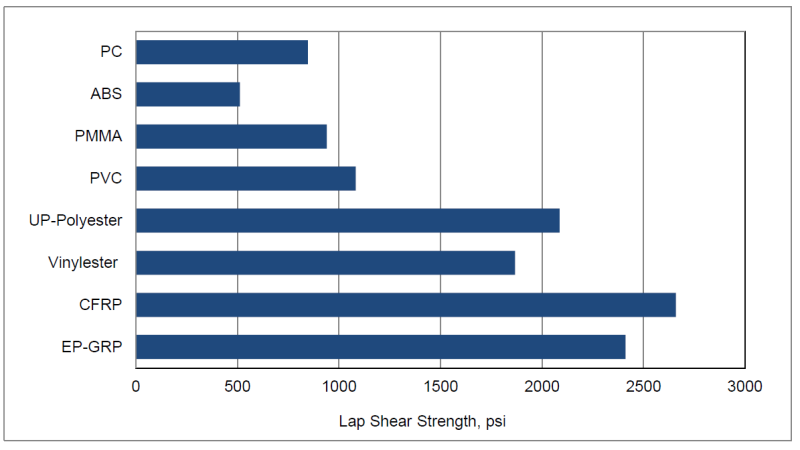
Lap shear strength versus temperature (ISO 4587) (typical average values).
- Substrates sandblasted and degreased with acetone.
- Cured 7 days at RT.
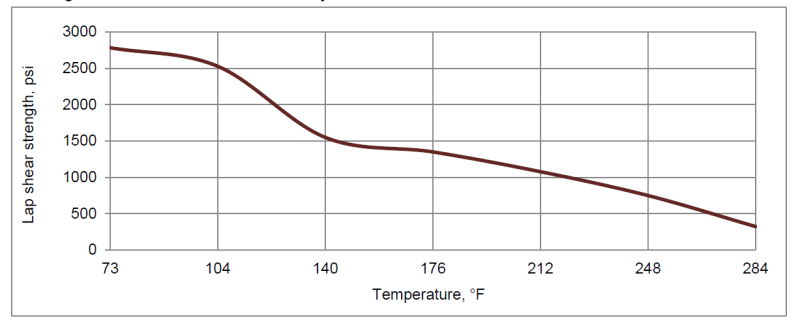
Lap shear after cycling ageing (typical average values)
- Cured for 7 days at RT and tested at 73°F.
- Reference sample: 28 days at 73°F / 50% relative humidity Humid-heat and cold (158°F 90% RH and -40°F) for 56 cycles (over 28 days) per ISO 9142/D4
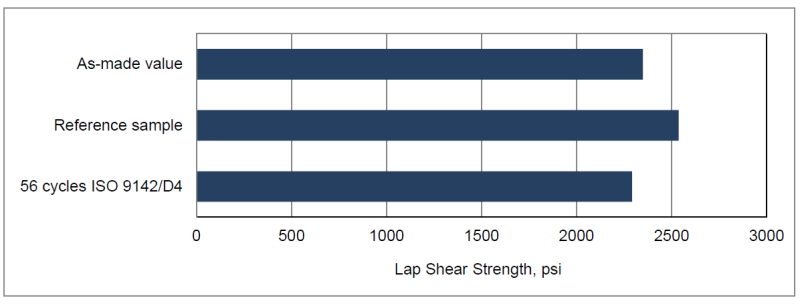
Lap shear strength versus Cataplasma ageing (typical average values)
Cured for 7 days at RT, then Cataplasma aged per ISO 9142/E2. Tested at 73°F.
Lap shear strength after coating post-cure cycle at 200°C (typical average values)
- Cured 7 days at RT and tested at 23°C. Substrates sandblasted and degreased with acetone.
- Ageing with a simulated coating post-cure cycle of 20 minutes at 200°C in an oven. Test performed at 23°C

Lap shear strength versus immersion in various media (ISO4587) (typical average values)
- On Aluminum L165, pretreatment: sandblasting.
- Cure: 7 days at RT. Tested at 23°C. LSS was determined after immersion for 30 days at 23°C.
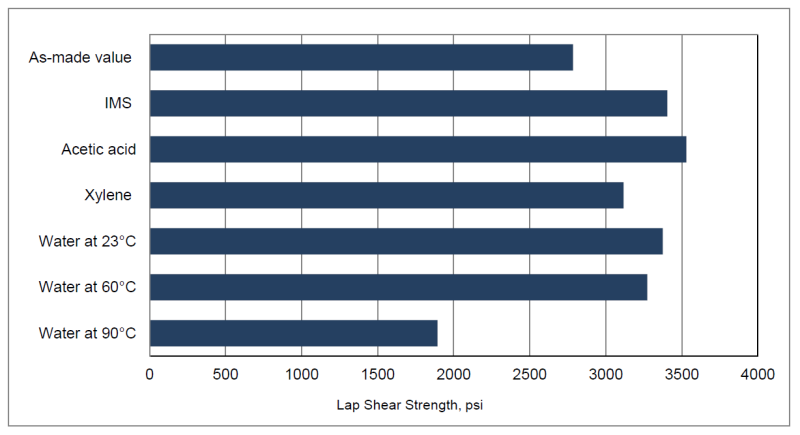
- Typical Physical Properties
- Unless otherwise stated, the figures given below were all determined by testing standard specimens made by lap-jointing 114 x 25 x 1.6 mm strips of aluminum alloy. The joint area was 12.5 x 25 mm in each case. The figures were determined with typical production batches using standard testing methods. They are provided solely as technical information and do not constitute a product specification.
- Average lap shear strengths of typical metal-to-metal joints (ISO 4587) (typical average values)
- Cured for 24 hours at RT and tested at 73°F. Substrates sandblasted and degreased with acetone. They are typical values only, and do not constitute a product specification.
-
-
Notes: ARALDITE® 2054-40 A/B is not suitable for galvanized steel - ARALDITE® 2047-1 or ARALDITE® 2051 can be used instead.
-
Average lap shear strengths of typical plastic-to-plastic joints (ISO 4587) (typical average values). Cured for 24 hours at RT and tested at 73°F. Substrates abraded and degreased with isopropanol.
-
-
Lap shear strength versus temperature (ISO 4587) (typical average values). Substrates sandblasted and degreased with acetone. Cured 7 days at RT.
-
-
Lap shear after cycling ageing (typical average values)
-
Cured for 7 days at RT and tested at 73°F. Reference sample: 28 days at 73°F / 50% relative humidity
-
Humid-heat and cold (158°F 90% RH and -40°F) for 56 cycles (over 28 days) per ISO 9142/D4
-
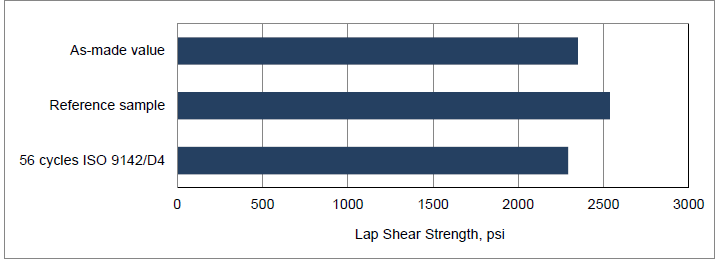
-
-
Lap shear strength versus Cataplasma ageing (typical average values)
-
Cured for 7 days at RT, then Cataplasma aged per ISO 9142/E2. Tested at 73°F.
-

-
-
Lap shear strength after coating post-cure cycle at 200°C (typical average values)
-
Cured 7 days at RT and tested at 23°C. Substrates sandblasted and degreased with acetone.
-
Ageing with a simulated coating post-cure cycle of 20 minutes at 200°C in an oven. Test performed at 23°C
-

-
-
Lap shear strength versus immersion in various media (ISO4587) (typical average values)
-
On Aluminum L165, pretreatment: sandblasting. Cure: 7 days at RT. Tested at 23°C. LSS was determined after immersion for 30 days at 23°C
-
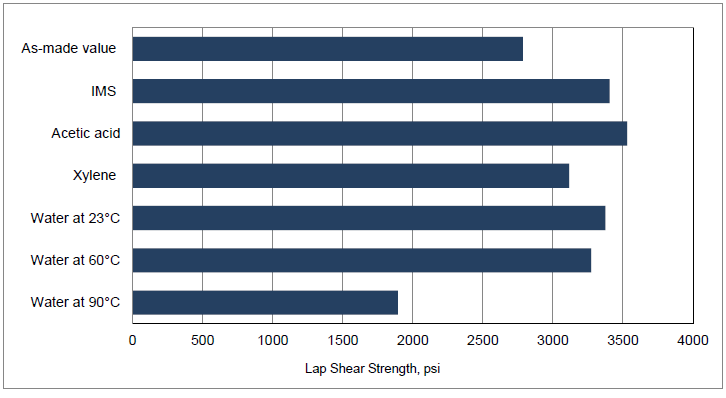
-
- Equipment Maintenance
- All tools should be cleaned with hot water and soap before adhesives residues have had time to cure.
- The removal of cured residues is a difficult and time-consuming operation.
- If solvents such as MEK are used for cleaning, operatives should take the appropriate precautions and, in addition, avoid skin and eye contact.
- Typical Times to Minimum Shear Strength on Sandblasted Aluminum / Contact Pressure
Property Value Unit Test Method Condition Cure Time to reach LSS min. 145 psi 176 min - at 10°C (50°F) Cure Time to reach LSS min. 1450 psi 210 min - at 10°C (50°F) Cure Time to reach LSS min. 145 psi 70 min - at 23°C (73°F) Cure Time to reach LSS min. 1450 psi 75 min - at 23°C (73°F) Cure Time to reach LSS min. 145 psi 25 min - at 30°C (86°F) Cure Time to reach LSS min. 1450 psi 30 min - at 30°C (86°F) Cure Time to reach LSS min. 145 psi 18 min - at 40°C (104°F) Cure Time to reach LSS min. 1450 psi 21 min - at 40°C (104°F)
Safety & Health
- Safety Information
Keep out of reach of children
Packaging & Availability
- Regional Availability
Storage & Handling
- Storage Conditions
- ARALDITE® 2054-40 A/B should be stored in a dry place, in the original sealed containers, at temperatures between 2°C and 8°C (36°F and 46°F). Under these storage conditions, the product has a shelf life of 450 days (from earliest date of production of either component). ARALDITE® 2054-40 A/B should not be exposed to direct sunlight. The product may be placed at room temperature before use, but the total time at room temperature should not exceed 270 days. Long term exposure above 25°C (77°F) will reduce the shelf life of the product.
- Storage and Shelf Life Information
- ARALDITE® 2054-40 A/B should be stored in a dry place, in the original sealed containers, at temperatures between 2°C and 8°C (36°F and 46°F).
- Under these storage conditions, the product has a shelf life of 450 days (from earliest date of production of either component).
- The product should not be exposed to direct sunlight.
- The product may be placed at room temperature before use, but the total time at room temperature should not exceed 270 days.
- Long term exposure above 25°C (77°F) will reduce the shelf life of the product.
Other
- Application Information
Value Units Test Method / Conditions Mix Ratio 0.12 %(W) %(W) Hardener : Resin - Physical Properties
Value Units Test Method / Conditions Lap Shear Strength min. 2175.0 psi psi Internal Method at 25°C Specific Gravity approx. 1.0 -

